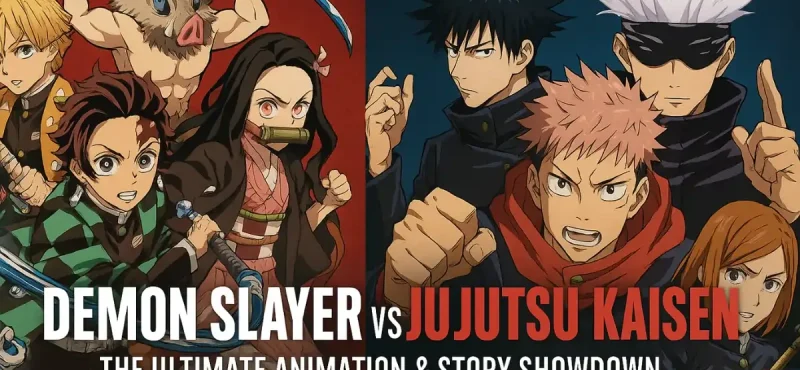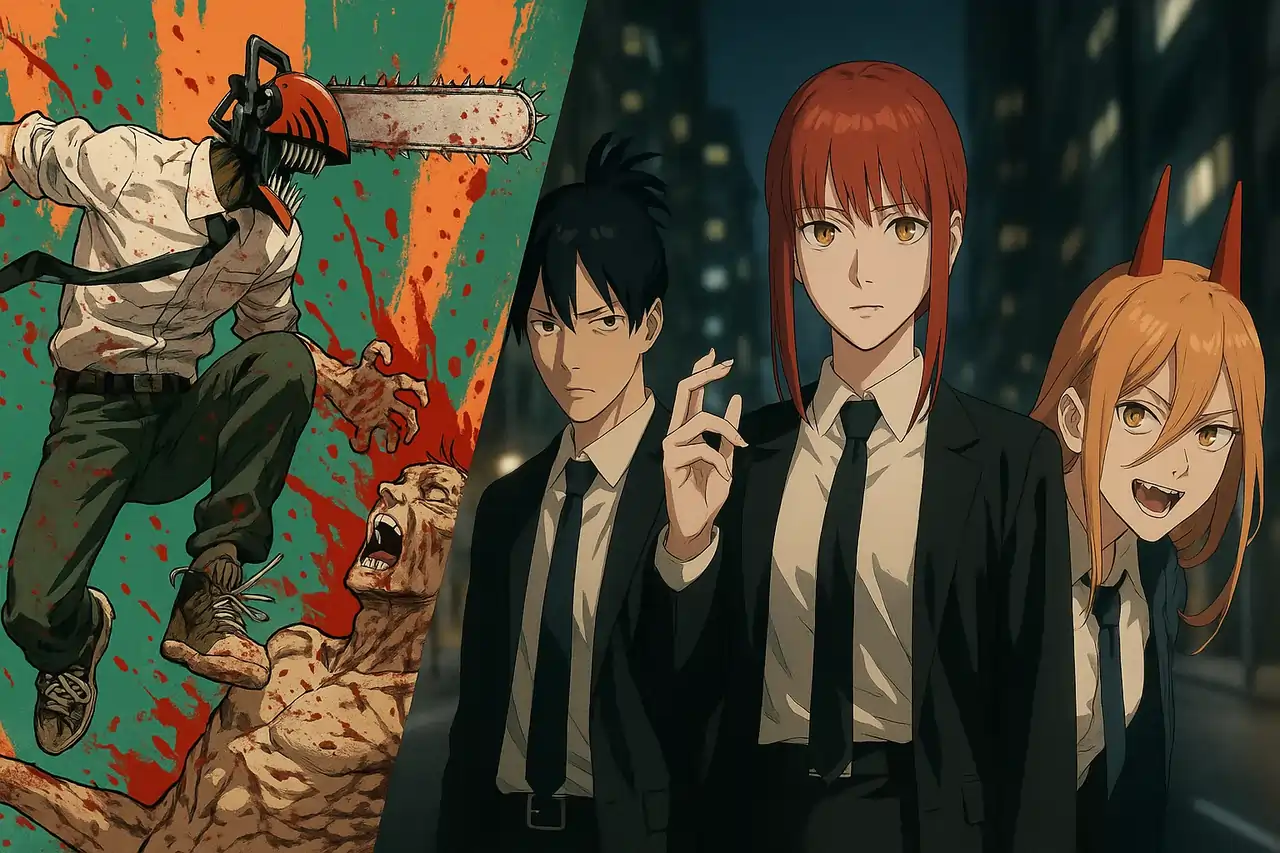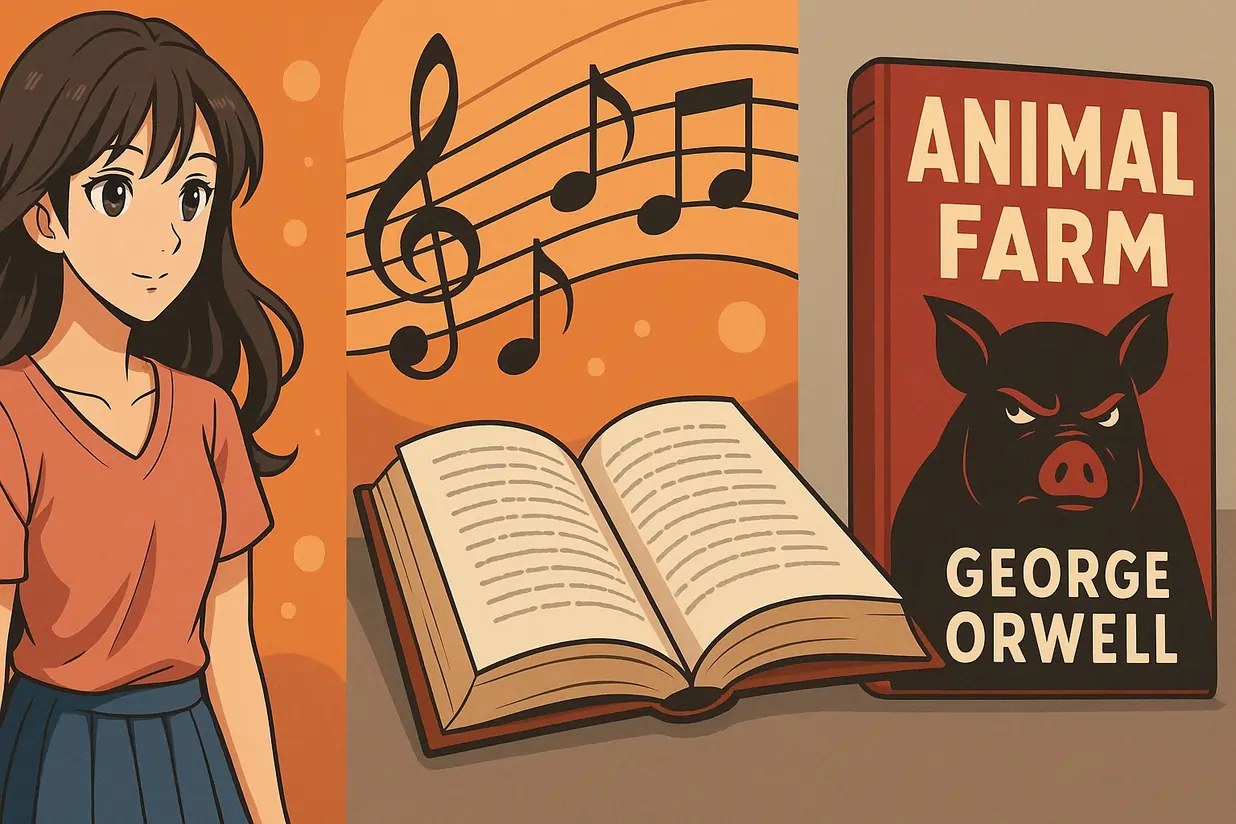If you ask any hardcore anime fan in 2025: What are the two defining shōnen series of the modern era?
Odds are the answer is Demon Slayer and Jujutsu Kaisen.
Why? Because these two didn’t just ride a wave they built new waves. And if you sit down with a bag of popcorn and your screen brightness up to max, you’ll see exactly why they stand out.
In this blog we’re going full geek-mode. We’ll compare:
- Story-tone & themes
- Animation, art-direction, visual design
- Character and world building
- Future potential (and where your studio Incredimate fits in)
- Why fans obsess, and where they diverge
Let’s go.
1. Story & Tone – Two Shōnen Siblings, Different DNA
Demon Slayer
Demon Slayer is a slow burner. It opens with tragedy: Tanjiro’s family slaughtered, sister turned demon. From there it becomes a fight for humanity, a fight for honour, and a fight for emotion. You don’t just watch blades slicing you feel every breath. The tone is deeply emotional, poetic, traditional yet hyper-modern in execution. It often asks: What does it mean to protect?
Its setting blends Taishō era Japan aesthetic with supernatural demons and breathing-techniques. The stakes feel personal. The pace gives you time to feel loss, hope, regret, redemption.
Jujutsu Kaisen
Jujutsu Kaisen is faster, sharper, edgier. The premise: Yuji Itadori swallows a cursed finger, becomes host to Sukuna, joins sorcerers fighting curses. Right away you’re in action. The tone is darker-humour mixed with horror elements, high stakes, more overt power scaling. It asks: What do you sacrifice to fight monsters? What does power corrupt?
The world is modern urban, curses lurking, sorcerers and monsters mixing. The characters are witty, the threats are brutal, the visuals are often mind-bending.
In short:
- Demon Slayer = emotion, tradition, heart, slow burn.
- Jujutsu Kaisen = speed, power, edge, modern horror-flair.
2. Animation & Art-Direction – Why Fans Can’t Stop Talking
Demon Slayer’s Visual Identity
From studio ufotable comes an animation style that fused 2D art with subtle 3D integration, brush-stroke effects, cinematic lighting basically, each fight scene feels like a hybrid of anime and a live-action montage. The trails behind blades, the water and fire effects, the fluidity of movement screams premium budget.
As an animation-studio-observer you’ll notice: the spacing of keyframes, the weight of impact, the way backgrounds reflect emotional tone. Demon Slayer sets a high bar for craft.
Fans constantly revisit scenes just to watch the motion (not just story).
Jujutsu Kaisen’s Visual Swagger
Studio MAPPA delivers Jujutsu Kaisen with a different kind of flair: bold, high energy, some rough edge that leans into chaos. The fight scenes employ dynamic camera angles, high contrast, ink-splatter effects, wild “domain expansion” visuals that look like surreal nightmares. The character designs are sharp, the pacing fast, the motion sometimes exaggerated intentionally to sell power.
It’s less elegant than Demon Slayer, but more unrestrained. It screams: power unleashed.
For any creative like Incredimate, watching how MAPPA layers effects during major fights is a master-class in “how to sell energy”.
Side-by-Side: What to Compare
- Motion economy: Demon Slayer often uses fewer frames but with intentional weight; Jujutsu Kaisen uses more frames, more motion blur, bigger impact.
- Effects: Demon Slayer’s fire/water are painterly; Jujutsu’s curses/domains are wild and graphic.
- Camera work: Demon Slayer uses slower dolly, subtle zoom; Jujutsu uses whip pans, strobe effect, hypercut.
- Tone via design: Demon Slayer backgrounds often reflect sorrow, isolation; Jujutsu backgrounds reflect madness, threat, distortion.
3. Character & World Building – Who You Root For and Why
Demon Slayer
Tanjiro, Nezuko, the Corps, the Hashira you get a team, you get personal stakes. Demon Slayer builds characters you care about. The demons often have tragic pasts, so even the monsters are sympathetic. The world expands slowly but meaningfully: villages, demon strongholds, training arcs.
You root not just for the win but for the healing. That emotional payoff is huge.
Jujutsu Kaisen
Yuji Itadori, Megumi, Nobara, Gojo immediate charisma, then depth. The world is layered: curses, sorcery schools, power politics. The characters evolve under pressure. The world doesn’t wait for you it often beats you down.
You root for survival, for escalation, for the next move.
Key difference
Demon Slayer asks: How do we heal?
Jujutsu Kaisen asks: How do we survive?
Both are compelling but in very different emotional registers.
4. Future Potential – Who’s Going Where & What That Means for Incredimate
Demon Slayer
Demon Slayer’s story arc is nearing its climax (or already there depending on the season). That means animation budgets will either keep soaring for final-boss battles, or shift into high craftsmanship for finales, use of new tech, maybe even theatrical majors. For Incredimate, this is a signal: finals of major series = opportunity for craft showcase, experimental visuals, high stakes.
If your studio wants to emplace itself in premium motion-design territory, studying Demon Slayer’s late-arc animation strategies (dense effects, hybrid 2D/3D lighting, brush-trail tech) is gold.
Jujutsu Kaisen
Jujutsu Kaisen is still in expansion mode. More arcs, more power, more domains, more experimental visuals. That offers studios like Incredimate a different kind of inspiration: scale. How to manage big battle scenes, how to keep characters readable under chaos, how to design “domain expansions” or power visuals that feel fresh.
In short: while Demon Slayer is refining, Jujutsu Kaisen is still exploring. For your studio, that means two possible paths: refinement mastery (learn from Demon) or creative escalation (learn from JJK).
Cross-studio Thinking
- Use Demon’s subtlety when designing emotionally directed scenes (character intros, training arcs).
- Use JJK’s explosive energy when designing showdowns, power-ups, big visuals.
- At Incredimate, you could categorize your project pipeline: training/character build-up = Demon style; major fight/climax = JJK style.
- Also consider budget allocation: high-impact big-set pieces deserve more frames/effects; emotional scenes can lean into minimalism and mood.
5. Why Fans Love Both & Compare Them Constantly
For Demon Slayer fans
- The animation quality is astounding.
- The heart, emotion, redemption arcs give them additive value.
- The blend of classic Japanese aesthetic + modern technique appeals to fans wanting depth and beauty.
- Many fans say: “I rewatch it just to watch the motion, not just the story.”
For Jujutsu Kaisen fans
- The fights are wild, fast, powerful.
- The characters feel edgy, modern, relatable to Gen Z.
- The world is expansive and the power system feels fresh (“cursed energy”, domains).
- It’s fun, dark, stylish it hits the “cool factor” turned up high.
The Comparison Reason
Because they share the same era and space.
Because fans want their anime to look good and feel good.
Because marketing/merchandise/attention span all lean to “which is better?” but really the fun part is: What do I love differently about each?
So threads of “Demon Slayer vs Jujutsu Kaisen” flood reddit, forums, social media.
6. Detailed Animation Breakdown – What I’d Highlight as a Studio Expert
Here, channeling Incredimate’s perspective: if I were designing a scene for either series, here’s what I’d pull out.
A. Key-frame spacing & motion
- In Demon Slayer: fewer frames on a strike, but heavy anticipation & follow-through. The overall motion feels weighty.
- In Jujutsu Kaisen: more frames, more blur, more “motion flash” to convey speed and power.
B. Effects layering
- Demon: fire and water tendrils have soft edges, organic variation, brushlike trails. Lighting glows softly.
- JJK: curses explode in shards, domains warp space, color saturation spikes, shadows crunch hard.
C. Background & camera
- Demon: backgrounds often rich, atmospheric, emotional context. Camera moves are smooth, elegant.
- JJK: backgrounds can warp, break, shake. Cameras whip-zoom, rotate, invert. Visually disruptive in service of chaos.
D. Sound & rhythm in fight design
- Demon: less is more. Silence, breath sounds, sword hum. Then a strike. The impact echoes.
- JJK: layered sound effects, voice cracks, power-sound buildup, whooshes, shockwaves. The soundscape is a track in itself.
E. Budget Design Insights
Your studio, Incredimate, can adopt hybrid design method:
- Use high-end brush-trail and frame layering for emotional sequences (a la Demon).
- Use saturation, motion blur, camera and effect chaos for major punch-fest sequences (a la JJK).
- Distribute your budget: smaller fights/emotional moments = less frame count but high design quality; big battles = high frame count + heavy effects + dynamic camera.
7. Future Thinking – What’s Next for Both Series & What That Means for Creatives
Demon Slayer’s Road Ahead
- Final arcs, big boss fights, maybe theatrical or high-budget seasons. Expect ultra-refined animation.
- Studios might push experimental visuals (new techniques in 2D/3D mixing, real-time effects).
- As fans, we’ll see: what happens when Tanjiro faces final demon, how design reflects culmination of journey.
For Incredimate: opportunity to build a “premium fight design” portfolio inspired by final Demon arcs.
Jujutsu Kaisen’s Road Ahead
- Still evolving: new arcs, new power systems, new characters.
- Greater scope for “world-building visuals” (domains, curses, multi-layered effects).
- As fans, expect bigger fights, freakier visuals, more risk.
For Incredimate: chance to design “sci-fi horror meets shōnen fight” visuals, experiment.
Crossover Potential & Studio Vision
Imagine combining both aesthetics: a scene that begins in Demon-style slow burn (setting tension, emotion), then flips into JJK-style full-on blast as the fight escalates. That hybrid style is gold for a studio like Incredimate wanting to stand out.
8. What I’d Recommend as a Fan & Creative
- Watch one episode of Demon Slayer just for the ambient fight design, note how the camera lingers, how frames are spaced.
- Watch one major fight from Jujutsu Kaisen just for speed, camera chaos, effect layering.
- Then take your notebook as a creator: mark what worked, what you can adapt for your own studio projects.
- For social content: create breakdown reels of “how Demon-style fight vs JJK-style fight would look” strong engagement.
- For future portfolio: design a mock “Demon meets JJK” fight storyboard – emotional build → explosion.
9. Why This Comparison Matters to Fans & Studios
For fans: It’s a debate. It’s fun. It’s “Which anime hits you right now?” But beneath the debate is love. Love for craft, love for motion, love for characters.
For studios like Incredimate: This comparison is a masterclass. Two different approaches to greatness. One emphasises emotion, one emphasises power. Study both and you’ll be ahead.
Final Thoughts – Two Legends, One Vision
Demon Slayer and Jujutsu Kaisen aren’t rivals they’re siblings. Both born in the same era of shōnen, both defining what modern anime can be.
- One shows us how beauty and emotion elevate a fight.
- The other shows us how power and chaos can mesmerize a generation.
As fans and as creators (like Incredimate) we don’t have to pick a side. We can take the calm flame of Demon Slayer and the roaring storm of JJK and use both in our own visual story world.
Because at the end of the day, anime isn’t about who’s better it’s about who moves you. And both of these moved an entire generation.
❓ FAQs (AEO + Human Tone)
Q1. Which anime has better animation, Demon Slayer or Jujutsu Kaisen?
Both are visual masterpieces in different ways. Demon Slayer, by Ufotable, focuses on elegant brush-stroke effects and cinematic lighting. Jujutsu Kaisen, by MAPPA, leans on chaotic camera angles, high-contrast energy, and domain expansions. Demon Slayer is poetry; Jujutsu Kaisen is lightning.
Q2. Who spends more on animation – Ufotable or MAPPA?
Ufotable’s animation for Demon Slayer is famous for its premium production values estimated budgets per episode are among the highest in anime. MAPPA, on the other hand, balances speed and style under tighter deadlines, relying on dynamic compositing and intense key-frame choreography. Both studios define different animation philosophies, not just budgets.
Q3. Which anime has a better storyline, Demon Slayer or Jujutsu Kaisen?
Demon Slayer tells a heartfelt story about family, grief, and redemption every demon fight feels personal. Jujutsu Kaisen explores modern darkness curses, trauma, and power systems rooted in fear. Demon Slayer moves your heart; JJK blows your mind.
Q4. Will Demon Slayer and Jujutsu Kaisen get more seasons or movies?
Yes! Demon Slayer’s story continues through the Infinity Castle movie trilogy (2025–2029). Jujutsu Kaisen still has major arcs to adapt fans can expect more seasons and possibly a sequel movie after the Shibuya Incident arc. The future for both looks massive.
Q5. Which studio is better: Ufotable or MAPPA?
That’s subjective. Ufotable crafts beautifully composed, emotion-heavy scenes that feel cinematic. MAPPA delivers fast, gritty, high-impact action that feels raw and alive. As an animation studio, Incredimate admires both — Ufotable for its artistry, MAPPA for its energy and blends lessons from both styles into our own visual storytelling.
Q6. Why do anime fans love comparing Demon Slayer and Jujutsu Kaisen?
Because both define this generation of anime. They came out in the same era, raised visual standards, and gave fans the best of both worlds emotion + power. Whether you prefer Tanjiro’s compassion or Gojo’s chaos, you’re still witnessing the golden age of anime.




